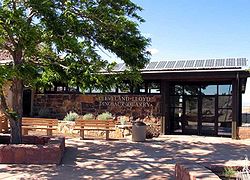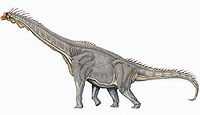- Cleveland Lloyd Dinosaur Quarry
-
The Cleveland Lloyd Dinosaur Quarry National Natural Landmark, located in The San Rafael Swell, near Cleveland, Utah contains the densest concentration of Jurassic dinosaur fossils ever found. Well over 15,000 bones have been excavated from this Jurassic 'predator trap' and there are many thousands more awaiting excavation and study. It was designated a National Natural Landmark in October 1965.[1]
Contents
Visiting
The visitor center is administered by the Bureau of Land Management. There is a skeleton reconstruction of an adult Allosaurus (and other bones) on display in the visitor center, along with many other exhibits. A renovated and expanded quarry visitor center was dedicated on April 28, 2007.
History
The quarry was probably found by sheepmen and cowmen as they drove their animals through the area during the late 19th century. In 1927, the Department of Geology at the University of Utah, under the direction of Chairman F.F. Hintze, visited the area and collected 800 bones. In 1939, a field party from Princeton University led by William Lee Stokes began work. In three summers, they collected 1,200 bones. The quarry was not worked again until 1960. In 1974, a new dinosaur was discovered by James H. Madsen, Jr., Assistant Research Professor of Geology and Geophysics, University of Utah, making him the first person to discover a new dinosaur out of the Morrison Formation in 75 years. He named it Stokesosaurus clevelandi. In 1979, another new dinosaur was found in the quarry by Madsen. He named it Marshosaurus bicentesimus. In 1987, Brigham Young University paleontologists excavated a fossil dinosaur egg, at the time the oldest such egg ever found.
Over the years, excavations led by the University of Utah and the Utah Museum of Natural History have resulted in the collection of more than 12,000 fossil bones from the quarry. While most of the original fossils are currently housed at the Utah Museum of Natural History, many skeletons reproduced from Cleveland-Lloyd dinosaur remains are now on exhibit in more than 65 museums worldwide. Original specimens from the quarry remain on public exhibit in Utah at the Utah Museum of Natural History in Salt Lake City, the College of Eastern Utah Prehistoric Museum in Price and the Earth Science Museum at Brigham Young University in Provo.
The U.S. Department of the Interior, Bureau of Land Management (BLM) opened a visitor center at the Cleveland-Lloyd Dinosaur Quarry in 1968. This was the first-ever BLM visitor center. On April 28, 2007 a new, larger facility was dedicated that has updated exhibits. The new visitor center generates its own electricity from rooftop solar panels.
Geology
The Cleveland-Lloyd Dinosaur Quarry of east central Utah has produced one of the most prolific dinosaurs bone assemblages in the Upper Jurassic beds of North America. The quarry is part of the Brushy Basin Member of the Morrison Formation. The fossil deposit, which is interpreted to be a possible predator trap, consists of a calcareous smectitic mudstone which accumulated on the floodplain of an anastomosing river system. An anastomosing river system consists of multiple interconnected channels confined by prominent levees separated by interchannel topographic lows. The depositional environment of the quarry mudstone was an interchannel seasonal accumulation of clay nested in a topographic low between channel levees called a floodpond.
Dinosaurs became entrapped in the cohesive and adhesive mud as they drank and hunted near the floodpond. The preserved fauna consists of almost all dinosaurs with the majority being carnivorous dinosaurs including Allosaurus (material from at least 44 individuals make up almost 67% of all remains), Torvosaurus (1), Ceratosaurus (1), Stokesosaurus (2), Marshosaurus (2), and possibly an Ornitholestes. Herbivorous dinosaurs include Camarasaurus (5), Haplocanthosaurus (1), Barosaurus (1), Amphicoelias (1), Mongolosaurus (1), an unidentified sauropod, Camptosaurus (5), Stegosaurus (4), a possible ankylosaur (1), and an unidentified ornithopod. Non-dinosaurian fauna include a crocodile (Goniopholis), 2 turtles (Glyptops), 4 genera of gastropoda (snails), and 4 genera of charophyte.
The atypical predator/prey ratio (3:1) represented at the quarry may be explained by pack hunting tendencies of Allosaurus. The high percentage of smaller individual allosaurs suggests that juveniles coordinated their efforts to capture and kill prey. They may have followed their prey into the floodpond and subsequently became mired themselves. The close spatial proximity of skull elements (most belonging to Allosaurus) supports this hypothesis. Larger individual theropods almost certainly became mired while attempting to scavenge the carcasses of other entrapped dinosaurs (Richmond and Morris, 1996).
Paleofauna
Fossil taxa discovered at the Cleveland-Lloyd site include:
- Plantae
- Thallophyta
- Aclistochara
- Latochara
- Stellatochara
- Thallophyta
- Animalia
- Mollusca
- Gastropoda
- Amplovalvata
- Amplovoluta
- Valvata
- Viviparus
- Gastropoda
- Chordata
- Chelonia
- Glyptops
- Chelonia
- Mollusca
Color key
Taxon Reclassified taxon Taxon falsely reported as present Discredited taxon Ichnotaxon Ootaxon Morphotaxon Notes
Uncertain or tentative data are in small text;crossed outdata are discredited.Theropods reported from the Cleveland-Lloyd Quarry Genus Species Amount Notes Images M. bicentesimus
2
A small 20 ft (6m) megalosaurid.
T. tanneri
1
The second laregest theropod reported from the Quarry.
S. clevelandi
3
The largest coelurosaur found
Indeterminate
1
-
A. fragilis
44 - 60
The largest theropod found
 Allosaurus mounted skeleton
Allosaurus mounted skeleton
C. nasicornis
1
The rarest theropod species in the quarry
Sauropods reported from the Cleveland-Lloyd Quarry Genus Species Notes Images C. lentus
3 skeletons were unearthed
B.lentus
-
A.altus
A smaller cousin of A.fragilimus
-
cf Indeterminate
-
-
B.althithorax
The largest dinosaur reported
H.priscus
The last Cetiosauridae
-
Ornithischians reported from the Cleveland-Lloyd Quarry Genus Species Notes Images C.dispar
-
-
S.stenops
The largest ornithischian of its time.
See also
References
- ^ NPS NNL Page
- ^ James H. Madsen. Allosaurus fragilis: a revised osteology.
- Stokes, W. L. 1985 The Cleveland-Lloyd Dinosaur Quarry: Window to the Past. U. S. Government Printing Office.
- Richmond, D.R. and Morris, T.H., 1996, The dinosaur death trap of the Cleveland-Lloyd Dinosaur Quarry, Emery County, Utah, in Morales, M., ed., The Continental Jurassic: Museum of Northern Arizona Bulletin 60, pp. 533–545.
External links
Coordinates: 39°19′22″N 110°41′22″W / 39.32282°N 110.689509°W
Categories:- Protected areas of Emery County, Utah
- Natural history of Utah
- Jurassic paleontological sites of North America
- National Natural Landmarks in Utah
- Museums in Emery County, Utah
- Natural history museums in Utah
- Dinosaur museums in the United States
- Bureau of Land Management areas in Utah
- Plantae
Wikimedia Foundation. 2010.





